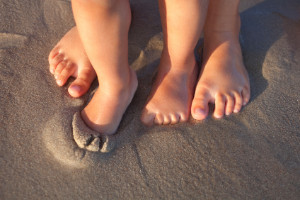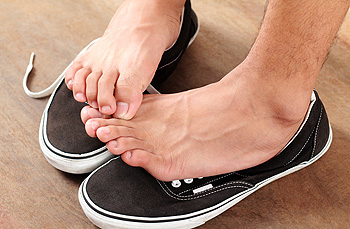Lansing (517) 321-1199

 A fungal infection that is referred to as athlete’s foot can be uncomfortable and painful. The most common place for this condition to develop is between the toes, which may cause severe itching. The skin may become dry and flaky, and many patients notice a burning or stinging sensation. This ailment is known to be contagious, and lives in warm and moist environments. These areas many include swimming pools, shower room floors, or locker rooms. Additionally, athlete’s foot may develop as a result of wearing shoes and socks that are too tight. This can contribute to sweaty feet, which may create an environment for the fungus to thrive. There are measures that can be implemented, which may help to prevent athlete’s foot. These may include wearing appropriate shoes in public areas and washing the feet and completely drying between the toes. If you are afflicted with this condition, it is suggested to consult with a podiatrist who can guide you toward proper treatment.
A fungal infection that is referred to as athlete’s foot can be uncomfortable and painful. The most common place for this condition to develop is between the toes, which may cause severe itching. The skin may become dry and flaky, and many patients notice a burning or stinging sensation. This ailment is known to be contagious, and lives in warm and moist environments. These areas many include swimming pools, shower room floors, or locker rooms. Additionally, athlete’s foot may develop as a result of wearing shoes and socks that are too tight. This can contribute to sweaty feet, which may create an environment for the fungus to thrive. There are measures that can be implemented, which may help to prevent athlete’s foot. These may include wearing appropriate shoes in public areas and washing the feet and completely drying between the toes. If you are afflicted with this condition, it is suggested to consult with a podiatrist who can guide you toward proper treatment.
Athlete’s foot is an inconvenient condition that can be easily reduced with the proper treatment. If you have any concerns about your feet and ankles, contact Dr. Harold Sterling from Michigan. Our doctor will treat your foot and ankle needs.
Athlete’s Foot: The Sole Story
Athlete's foot, also known as tinea pedis, can be an extremely contagious foot infection. It is commonly contracted in public changing areas and bathrooms, dormitory style living quarters, around locker rooms and public swimming pools, or anywhere your feet often come into contact with other people.
Solutions to Combat Athlete’s Foot
Athlete’s foot can cause many irritating symptoms such as dry and flaking skin, itching, and redness. Some more severe symptoms can include bleeding and cracked skin, intense itching and burning, and even pain when walking. In the worst cases, Athlete’s foot can cause blistering as well. Speak to your podiatrist for a better understanding of the different causes of Athlete’s foot, as well as help in determining which treatment options are best for you.
If you have any questions please feel free to contact our office located in Lansing, MI. We offer the newest diagnostic and treatment technologies for all your foot and ankle needs.
Read more about How to Deal with Athlete's Foot Research has indicated the majority of babies are born with flat feet. This may be a result of underdeveloped bones, muscles and ligaments that exist in many babies. The foot generally becomes stronger as the child begins to walk, and the arch may begin to develop. It may be beneficial for the child to walk barefoot indoors as often as possible. This may help to promote balance, coordination and posture. When the child walks outdoors, it is important to choose shoes that fit correctly. This can be accomplished by measuring the child’s feet frequently, which can determine the correct size. A shoe that fits properly will be comfortable, and will have adequate room for the toes to move freely. Additionally, the sole should be flat and made of a flexible material so the foot can easily bend. If you would like additional information about how to choose shoes for your child, please speak to a podiatrist who can properly assist you.
Research has indicated the majority of babies are born with flat feet. This may be a result of underdeveloped bones, muscles and ligaments that exist in many babies. The foot generally becomes stronger as the child begins to walk, and the arch may begin to develop. It may be beneficial for the child to walk barefoot indoors as often as possible. This may help to promote balance, coordination and posture. When the child walks outdoors, it is important to choose shoes that fit correctly. This can be accomplished by measuring the child’s feet frequently, which can determine the correct size. A shoe that fits properly will be comfortable, and will have adequate room for the toes to move freely. Additionally, the sole should be flat and made of a flexible material so the foot can easily bend. If you would like additional information about how to choose shoes for your child, please speak to a podiatrist who can properly assist you.
The health of a child’s feet is vital to their overall well-being. If you have any questions regarding foot health, contact Dr. Harold Sterling of Michigan. Our doctor can provide the care you need to keep you pain-free and on your feet.
Tips for Keeping Children's Feet Healthy
If you have any questions, please feel free to contact our office located in Lansing, MI. We offer the newest diagnostic and treatment technologies for all your foot care needs.
Read more about How to Care for Your Child's Feet Hyperhidrosis is the medical term for a condition that causes excessive sweating all over the body. Plantar hyperhidrosis is a form of this condition that specifically affects the feet. This ailment usually begins in childhood or adolescence, and in severe cases can cause some physical limitations. The extra moisture can make the feet more prone to bacterial or fungal infections and blisters. Tinea pedis and pitted keratolysis are two examples of possible infections that can result from excess moisture. These two infections can easily be treated with antifungal cream, antibiotic cream, or medication. Plantar hyperhidrosis is symmetric, so it affects both feet equally. The sweating can range from mild excessive sweating to severe constant sweating. If you think you may have plantar hyperhidrosis, then it is recommended you consult with a podiatrist to learn new methods to help living with this condition.
Hyperhidrosis is the medical term for a condition that causes excessive sweating all over the body. Plantar hyperhidrosis is a form of this condition that specifically affects the feet. This ailment usually begins in childhood or adolescence, and in severe cases can cause some physical limitations. The extra moisture can make the feet more prone to bacterial or fungal infections and blisters. Tinea pedis and pitted keratolysis are two examples of possible infections that can result from excess moisture. These two infections can easily be treated with antifungal cream, antibiotic cream, or medication. Plantar hyperhidrosis is symmetric, so it affects both feet equally. The sweating can range from mild excessive sweating to severe constant sweating. If you think you may have plantar hyperhidrosis, then it is recommended you consult with a podiatrist to learn new methods to help living with this condition.
If you are suffering from hyperhidrosis contact Dr. Harold Sterling of Michigan. Our doctor can provide the care you need to attend to all of your foot and ankle needs.
Hyperhidrosis of the Feet
Hyperhidrosis is a rare disorder that can cause people to have excessive sweating of their feet. This can usually occur all on its own without rigorous activity involved. People who suffer from hyperhidrosis may also experience sweaty palms.
Although it is said that sweating is a healthy process meant to cool down the body temperature and to maintain a proper internal temperature, hyperhidrosis may prove to be a huge hindrance on a person’s everyday life.
Plantar hyperhidrosis is considered to be the main form of hyperhidrosis. Secondary hyperhidrosis can refer to sweating that occurs in areas other than the feet or hands and armpits. Often this may be a sign of it being related to another medical condition such as menopause, hyperthyroidism and even Parkinson’s disease.
In order to alleviate this condition, it is important to see your doctor so that they may prescribe the necessary medications so that you can begin to live a normal life again. If this is left untreated, it is said that it will persist throughout an individual’s life.
A last resort approach would be surgery, but it is best to speak with your doctor to find out what may be the best treatment for you.
If you have any questions please feel free to contact our office located in Lansing, MI. We offer the newest diagnostic and treatment technologies for all your foot and ankle needs.
Read more about Hyperhidrosis of the Feet